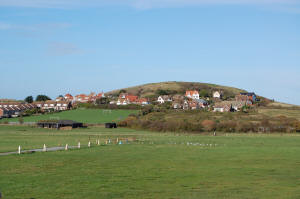|
|
|
|
Beeston Regis
|
| Beeston Regis lies on the North Norfolk coast
between Sheringham and
West Runton. It's famous
for its hill (Beeston Bump) - which saw service in World
War II as a signals intelligence location - for All Saints
Church which stands on the edge of a large caravan park
and for the remains of an Augustinian Priory.

Beeston Bump
According to legend, Beeston Bump is also the lair of
Black Shuck - a terrifying black hound with fiery-red
eyes - who occasionally prowls the hills of North
Norfolk and whose appearance, for the unlucky viewer, is
a pre-cursor for death. The legend of Black Shuck
undoubtedly affected Sir Arthur Conan Doyle when he
visited the area in 1901 for a golfing holiday. He
stayed at the Royal Links Hotel in
Cromer and went to dinner with Benjamin Bond Cabbell
at Cromer Hall who is
thought to have planted the seed of an ancient family
afflicted by a terrible curse - which inspired
Conan Doyle to write one of his most gripping Sherlock
Holmes adventures ever - namely The Hound of the
Baskervilles.
Another writer who visited this part of the North
Norfolk coast was the Australian poet Francis Webb (1925-73). He was a patient at the David Rice Hospital in
Drayton from 1956-1960 but was
allowed out on certain therapeutic visits. Webb wrote a
number of poems about Norfolk including one entitled Beeston
Regis - a challenging piece which reaches a
delightful conclusion when it focuses upon Beeston
priory and the monks who used to worship here:
|
Saxon, Norman, the Priory has answered
Time and wind and space, come into ruins
Lovingly, crumbled, O tumbled zealously.
The Mass, or cantata of wind in the tall stones.
And space between:
Dust is the silent labours of the men in their long
robes,
But they are here, they move,
Genuflect, tell their beads in the dancing light,
They are risen, they rise.
Walls, mankind, yes something of hungry earth
Melt into everlastingness, which is this hour.
In the arising is the Calvary,
And the beauty of the passing. |
Webb left England in 1960 and returned to Australia -
taking all of his poems with him. Fortunately his
Norfolk connection has recently come to light thanks to
the Australian academic Dr Toby Davidson - who contacted
this website.
|
Links:
More photographs of Beeston Regis
Francis Webb: Norfolk Location Photographs
More Norfolk Sherlock Holmes photos |
|
|
|

